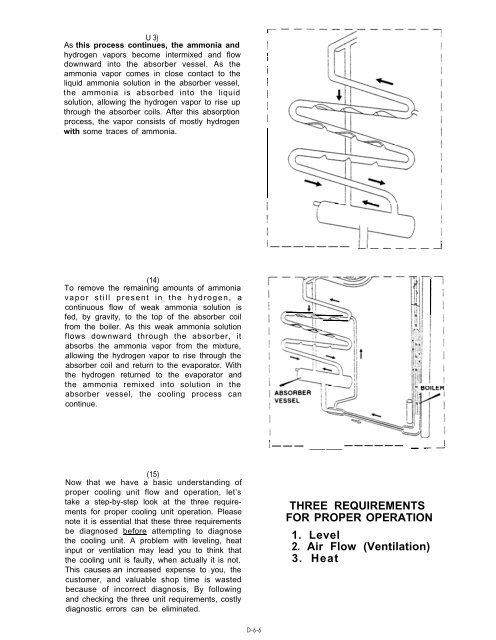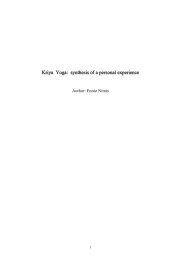Dometic Manual Refrigerator Diagnostic Service Manual - WebRing
Dometic Manual Refrigerator Diagnostic Service Manual - WebRing
Dometic Manual Refrigerator Diagnostic Service Manual - WebRing
You also want an ePaper? Increase the reach of your titles
YUMPU automatically turns print PDFs into web optimized ePapers that Google loves.
U 3)<br />
As this process continues, the ammonia and<br />
hydrogen vapors become intermixed and flow<br />
downward into the absorber vessel. As the<br />
ammonia vapor comes in close contact to the<br />
I<br />
1<br />
I<br />
I<br />
liquid ammonia solution in the absorber vessel, I<br />
the ammonia is absorbed into the liquid<br />
solution, allowing the hydrogen vapor to rise up<br />
through the absorber coils. After this absorption<br />
I<br />
I<br />
process, the vapor consists of mostly hydrogen<br />
with some traces of ammonia.<br />
I<br />
(14)<br />
To remove the remaining amounts of ammonia<br />
vapor still present in the hydrogen, a<br />
continuous flow of weak ammonia solution is<br />
fed, by gravity, to the top of the absorber coil<br />
from the boiler. As this weak ammonia solution<br />
flows downward through the absorber, it<br />
absorbs the ammonia vapor from the mixture,<br />
allowing the hydrogen vapor to rise through the<br />
absorber coil and return to the evaporator. With<br />
the hydrogen returned to the evaporator and<br />
the ammonia remixed into solution in the<br />
absorber vessel, the cooling process can<br />
continue.<br />
(15)<br />
Now that we have a basic understanding of<br />
proper cooling unit flow and operation, let’s<br />
take a step-by-step look at the three requirements<br />
for proper cooling unit operation. Please<br />
note it is essential that these three requirements<br />
be diagnosed before attempting to diagnose<br />
the cooling unit. A problem with leveling, heat<br />
input or ventilation may lead you to think that<br />
the cooling unit is faulty, when actually it is not.<br />
This causes an increased expense to you, the<br />
customer, and valuable shop time is wasted<br />
because of incorrect diagnosis, By following<br />
and checking the three unit requirements, costly<br />
diagnostic errors can be eliminated.<br />
D-6-6<br />
I--<br />
------- Ll_____i<br />
I<br />
---__------ I __A<br />
THREE REQUIREMENTS<br />
FOR PROPER OPERATION<br />
1. Level<br />
2. Air Flow (Ventilation)<br />
3. Heat

















